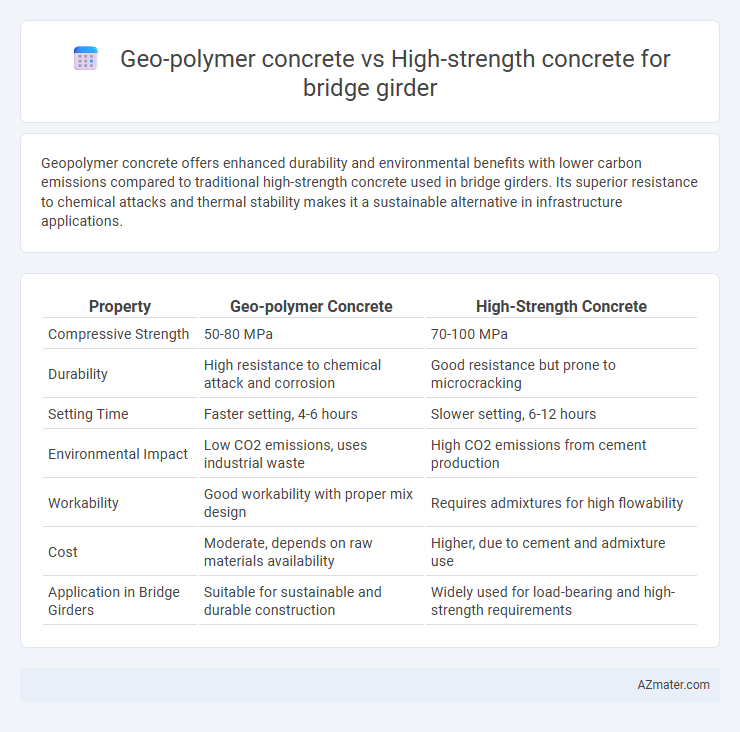Geopolymer concrete offers enhanced durability and environmental benefits with lower carbon emissions compared to traditional high-strength concrete used in bridge girders. Its superior resistance to chemical attacks and thermal stability makes it a sustainable alternative in infrastructure applications.
Table of Comparison
| Property | Geo-polymer Concrete | High-Strength Concrete |
|---|---|---|
| Compressive Strength | 50-80 MPa | 70-100 MPa |
| Durability | High resistance to chemical attack and corrosion | Good resistance but prone to microcracking |
| Setting Time | Faster setting, 4-6 hours | Slower setting, 6-12 hours |
| Environmental Impact | Low CO2 emissions, uses industrial waste | High CO2 emissions from cement production |
| Workability | Good workability with proper mix design | Requires admixtures for high flowability |
| Cost | Moderate, depends on raw materials availability | Higher, due to cement and admixture use |
| Application in Bridge Girders | Suitable for sustainable and durable construction | Widely used for load-bearing and high-strength requirements |
Introduction to Bridge Girder Materials
Bridge girders demand materials with high load-bearing capacity and durability, making the choice between geo-polymer concrete and high-strength concrete critical. Geo-polymer concrete offers enhanced chemical resistance and sustainability due to its industrial by-product composition, while high-strength concrete delivers superior compressive strength and established performance in heavy load applications. Selecting the appropriate material impacts the girder's lifespan, maintenance costs, and structural integrity under dynamic and environmental stresses.
Overview of Geo-polymer Concrete
Geo-polymer concrete is an innovative, eco-friendly alternative to traditional Portland cement-based concrete, offering excellent mechanical properties and durable performance for bridge girders. It utilizes industrial by-products such as fly ash or slag activated by alkaline solutions, resulting in high compressive strength and enhanced resistance to chemical attacks and high temperatures. Its reduced carbon footprint and superior long-term durability make geo-polymer concrete a promising material for sustainable infrastructure development.
Fundamentals of High-strength Concrete
High-strength concrete (HSC) used in bridge girders is characterized by its compressive strength exceeding 50 MPa, achieved through low water-cement ratios and advanced mix designs incorporating silica fume and superplasticizers. The dense microstructure of HSC results in enhanced durability, reduced permeability, and superior mechanical properties essential for load-bearing performance in bridge applications. Compared to geopolymer concrete, HSC relies on Portland cement hydration chemistry, necessitating careful curing regimes to optimize early-age strength and minimize shrinkage-related cracking.
Material Composition and Characteristics
Geopolymer concrete for bridge girders is primarily composed of industrial by-products like fly ash or slag activated with alkaline solutions, resulting in a material with excellent chemical resistance and lower carbon footprint compared to traditional cement-based mixes. High-strength concrete typically relies on low water-cement ratios and the incorporation of supplementary cementitious materials to achieve compressive strengths above 60 MPa, offering superior load-bearing capacity and durability. The unique chemical structure of geopolymer concrete provides enhanced thermal stability and resistance to aggressive environments, while high-strength concrete emphasizes mechanical performance and long-term structural integrity.
Mechanical Properties Comparison
Geopolymer concrete exhibits superior durability and chemical resistance compared to high-strength concrete, making it ideal for bridge girders exposed to aggressive environments. While high-strength concrete offers higher compressive strength typically ranging from 70 to 100 MPa, geopolymer concrete provides comparable strength with enhanced resistance to thermal cracking and shrinkage. Studies show geopolymer concrete achieves flexural strength of 8-12 MPa and split tensile strength close to 5 MPa, which supports long-span bridge girders under dynamic loading conditions.
Durability and Longevity
Geo-polymer concrete exhibits superior durability and longevity for bridge girders due to its enhanced resistance to chemical attack, chloride ingress, and high-temperature exposure compared to traditional high-strength concrete. The alkali-activated binder in geo-polymer concrete reduces permeability, mitigating corrosion risks and extending structural lifespan. High-strength concrete, while possessing greater compressive strength, often suffers from microcracking and reduced resistance to aggressive environments, potentially compromising long-term performance in bridge applications.
Environmental Impact and Sustainability
Geo-polymer concrete significantly reduces carbon emissions by utilizing industrial by-products like fly ash and slag, offering a sustainable alternative to traditional high-strength concrete, which relies heavily on Portland cement production. Its lower alkaline leachate potential and enhanced durability extend the service life of bridge girders, decreasing the frequency of repairs and material consumption. The decreased reliance on natural resources and lower embodied energy of geo-polymer concrete contribute to a reduced environmental footprint in large infrastructure projects.
Cost Analysis and Economic Viability
Geo-polymer concrete offers significant cost advantages over high-strength concrete for bridge girders due to its utilization of industrial by-products like fly ash, reducing raw material expenses and energy consumption during production. High-strength concrete demands higher cement content and specialized admixtures, increasing overall project costs and carbon footprint. Economic viability favors geo-polymer concrete when considering long-term durability, reduced maintenance costs, and lower emissions, making it a financially and environmentally sustainable choice for infrastructure projects.
Construction Techniques and Practical Challenges
Geopolymer concrete for bridge girders offers advantages such as reduced curing time and enhanced resistance to chemical attacks compared to high-strength concrete, which typically requires extended curing periods and strict temperature controls during construction. Practical challenges with geopolymer concrete include the need for precise mix design to ensure consistent properties and the limited availability of standardized guidelines, whereas high-strength concrete faces issues like brittleness and the risk of microcracking under stress. Construction techniques for geopolymer concrete involve specialized handling of alkaline activators and ambient curing methods, contrasting with the conventional formwork and vibrating compaction processes used for high-strength concrete.
Suitability for Bridge Girder Applications
Geopolymer concrete offers superior chemical resistance, reduced carbon footprint, and excellent durability, making it highly suitable for bridge girders exposed to aggressive environments and requiring long service life. High-strength concrete provides exceptional compressive strength and load-bearing capacity, ideal for bridge girders subjected to heavy traffic and high stresses. The choice depends on project-specific factors such as environmental exposure, sustainability goals, and structural demands.

Infographic: Geo-polymer concrete vs High-strength concrete for Bridge girder
 azmater.com
azmater.com